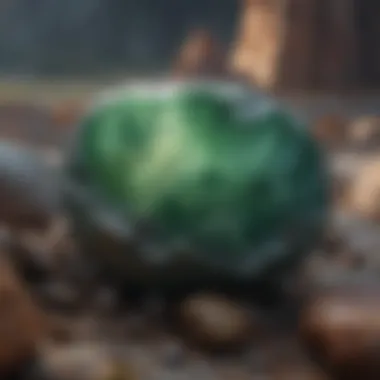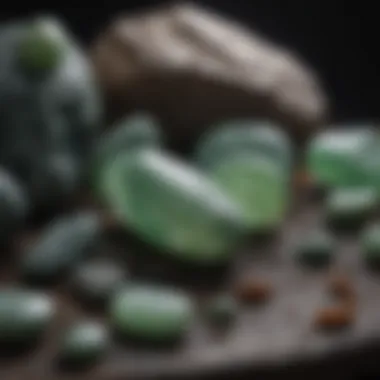Exploring the Rich Legacy of Canadian Jade


Intro
The allure of jade, particularly its Canadian varieties, captivates collectors and enthusiasts alike. This article serves as a thorough examination of Canadian jade, shedding light on its geological origins, diverse forms, and cultural significance. As we delve into the mineral properties, extraction processes, and applications, it is crucial to recognize the context in which jade has evolved in Canada. The synthesis of historical relevance and contemporary market dynamics will provide insight for rock and fossil collectors interested in this cherished gemstone.
History and Origins
Canadian jade has roots that reach deep into the planet’s geological history. Found primarily in regions such as British Columbia, the jade forms here stem from unique geological processes that have unfolded over millions of years. These origins can be traced back to the transformation of metamorphic rocks under intense heat and pressure, resulting in the formation of nephrite and jadeite, two primary types of jade.
Overview of Collectibles, Rocks, and Fossils
For collectors, jade holds a distinctive position among other stones and fossils. The mineral composition of jade, primarily consisting of silicate minerals, varies depending on its type. Nephrite, being the more common form in Canada, is a tough stone known for its rich greens and smoother texture. In contrast, jadeite is rarer in Canadian deposits but is prized for its vivid colors and crystalline structure.
Significant Characteristics:
- Nephrite: Generally seen in green to black hues with a fibrous texture.
- Jadeite: Offers a wider color palette, including white, lavender, and deep green.
Historical Significance and Cultural Impact
The significance of jade in Canadian history cannot be overstated. Indigenous cultures have long revered jade, crafting tools, ornaments, and ceremonial items from the stone. This connection highlights jade's status beyond mere aesthetics; it carries spiritual and cultural meanings. Today, jade continues to be a vital part of the cultural identity for many Indigenous groups, emphasizing its role in oral traditions and artistic practices.
"Jade is not just a stone; it is a testament to the craftsmanship and cultural depth of the societies that embrace it."
Identification and Classification
For those engaged in the collection and appreciation of jade, understanding its identification and classification is vital. Knowing how to distinguish between various forms aids in recognizing authenticity and value.
Guide to Identifying Rocks and Fossils
When identifying jade, collectors should consider several characteristics:
- Color: Look closely at the stone's hue, noting any variations.
- Texture: Compare the smoothness and luster of the stone.
- Translucency: Check if it allows light to pass through; jade can exhibit varying levels of translucency.
Common Types and Variations
Canadian jade is classified primarily into two types:
- Nephrite: Predominantly found in British Columbia, it is dense and tough, making it more durable.
- Jadeite: Though rarer in Canada, jadeite is valued for its vibrant colors and can be found alongside nephrite in some deposits.
Recognizing these differences not only enhances the collection experience but also deepens appreciation for the geological artistry represented by Canadian jade.
Prolusion to Canadian Jade
Understanding the significance of Canadian jade serves as a vital starting point for appreciating its unique traits and cultural implications. This section not only lays the groundwork for later discussions but also positions jade as an important subject of inquiry within geology and art. By exploring both the geological and cultural aspects of jade, readers gain insight into its multifaceted nature.
What is Jade?
Jade is often misconceived as a single mineral; however, it refers to two distinct minerals, nephrite and jadeite. Nephrite is more prevalent and is known for its range of greenish hues. Jadeite, on the other hand, comes in various colors and is generally rarer, making it more valuable. Both types have unique physical and chemical properties, which contribute to their popularity in jewelry and ornamental arts. Jade has been treasured for thousands of years across various cultures, especially in Asia and among indigenous peoples of North America. Its toughness and ability to be polished to a high sheen make it ideal for carvings, tools, and decorative items.
Overview of Canadian Jade
Canadian jade primarily comes from two key regions: British Columbia and the Yukon Territory. These areas host significant nephrite deposits. The jade found here has gained international acclaim not just for its quality, but also for its cultural significance. In British Columbia, jade has been part of Indigenous heritage for generations, utilized in both traditional and modern contexts. Furthermore, the commercial value of Canadian jade has been rising. It is sought after for its beauty and believed metaphysical properties. The growth in demand reveals the deep connection people have with this mineral beyond its aesthetic appeal. This exploration into Canadian jade is crucial for anyone interested in rocks and minerals, as it encapsulates geological formation, cultural heritage, and market dynamics.


Geological Formation
The geological formation of jade is a fundamental aspect to understanding its characteristics and value, especially in the context of Canadian jade. Understanding how jade is formed allows collectors and enthusiasts to appreciate the conditions and processes that produce such a sought-after stone. This section focuses on the mineral composition of jade, detailing the unique varieties found in Canada and examining the formation processes that result in the creation of jadeite and nephrite.
Mineral Composition of Jade
Jade is primarily composed of two different minerals: nephrite and jadeite. Each type has distinctive properties that contribute to its desirability in various uses.
Nephrite vs. Jadeite
Nephrite is typically a softer, more fibrous form of jade, while jadeite is denser and often more visually striking. The key characteristic of nephrite is its toughness, which lends itself well to carvings and intricate designs. Collectors often praise nephrite for its rich history and cultural significance, especially among indigenous peoples of Canada.
In contrast, jadeite is known for a wider range of colors and greater transparency. It often fetches higher prices in the market due to its rarity. Collectors seek jadeite for its unique aesthetic qualities and its potential as an investment. The main disadvantage lies in its comparative fragility, making it less suitable for high-impact use. Therefore, both nephrite and jadeite hold valuable places in the world of jade, each catering to different preferences.
Elemental Properties
The elemental properties of jade directly impact its classification and use. Nephrite, composed largely of actinolite, has a complex structure that allows for its characteristic green and black hues. Jadeite, on the other hand, is a pyroxene mineral rich in sodium and aluminum, allowing for vibrant colors ranging from white to deep green.
These characteristics define the unique features of jade in different contexts. Nephrite is often favored in traditional ceremonies, while jadeite is more commonly used in contemporary jewelry designs.
Formation Processes
The processes through which jade is formed play a significant role in its physical and chemical properties. Understanding these processes also reveals why certain jade characteristics are more sought after than others.
Metamorphism
Metamorphic processes involve the alteration of pre-existing rocks under heat and pressure. This is a key method in the formation of nephrite jade. The specific conditions necessary for nephrite's emergence require considerable geological activity. As such, nephrite is often found in regions with a history of tectonic movement. The advantage of nephrite resulting from metamorphism is its inherent toughness, making it a preferred choice for various applications.
Hydrothermal Activity
Hydrothermal activity refers to the circulation of mineral-rich fluids through rock formations. This process primarily contributes to the formation of jadeite. The unique feature of jadeite formation through hydrothermal means is the gem's ability to incorporate a diverse array of minerals, influencing its colors and clarity. Collectors often value jadeite because of its multifaceted nature and the potential for beauty.
In summary, the geological formation of jade is not just about mineral type but also the processes that lead to its creation. Collectors interested in jade should recognize how these elements combine to create the striking gems available today. Understanding these foundational aspects will enhance their appreciation and knowledge of Canadian jade.
Major Sources of Canadian Jade
Understanding the major sources of Canadian jade is crucial to appreciating its geological significance and economic value. Canada is home to some of the finest jade deposits, predominantly found in British Columbia and the Yukon Territory. Each region provides unique mineral varieties, extraction methods, and cultural relevance. This section highlights these aspects, illustrating how they contribute to the gem's allure and its importance in both natural and human contexts.
British Columbia
Regionally Significant Deposits
British Columbia is a hub for jade deposits. The region boasts significant nephrite jade sources, particularly in areas like the Cassiar Mountains. This type of jade is recognized for its durability and rich green hues. The deposits here often yield large boulders, suitable for carving and jewelry-making. The accessibility to these materials enhances the local economy and supports artisanal crafts.
What makes British Columbia's deposits particularly noteworthy is their geological history. Formed through intense metamorphic processes, these deposits reflect a unique combination of heat and pressure, impacting the quality of the jade. The abundant nephrite found here has made it a preferred choice among collectors and artisans alike due to its attractive aesthetics and robustness. The extraction of jade from these deposits also comes with environmental considerations, prompting discussions on sustainable practices in mining.
Extraction Practices
The extraction practices in British Columbia are a key element influencing the jade market. Most jade is harvested through open-pit mining, a method that allows for efficient access to large boulders. This technique, while economically beneficial, raises environmental concerns about land disturbance and habitat destruction. Thus, responsible mining techniques are being adopted to mitigate the impact on the ecosystem.
Local regulations have also encouraged the use of sustainable extraction methods, promoting practices that minimize environmental harm. This commitment to sustainability not only protects local biodiversity but also ensures that the jade mining can continue without depleting resources. These practices offer a beneficial reputation to the jade industry, making it an often-selected topic among environmental advocates.
Yukon Territory


Geological Features
In the Yukon Territory, jade deposits are found within a complex geological framework that includes metamorphic and sedimentary rocks. The Kluane Range is particularly notable for its distinct types of jade, including both nephrite and jadeite. This variety enriches the local geological landscape and provides a depth of options for collectors.
The geological features of the Yukon provide an additional intrigue due to their unique formations. Being one of the less accessible areas for mining, the jade here often retains high quality and purity, appealing to artisans aiming for premium materials. The remote location also fortifies conservation efforts, prompting interest among rock and mineral enthusiasts who appreciate the authenticity and exclusivity of Yukon jade.
Local Mining Operations
Local mining operations in the Yukon are characterized by smaller scale, artisanal efforts compared to British Columbia. These operations tend to prioritize sustainable practices due to the delicate ecosystems in which they work. Many of these mines are family-owned, instilling a strong cultural pride and connection to the land.
The operations often focus on providing a more personalized approach to jade extraction. This results in a careful selection process that respects environmental sustainability while contributing to local economies. The advantage of these small-scale operations is the potential for higher quality jade, as miners can invest more time in extraction, helping to ensure the gem's flawless nature.
Cultural Significance
The cultural importance of jade in Canada is profound, intertwining the stone with the identities and traditions of various communities, particularly Indigenous peoples. Jade is not merely a gemstone; it symbolizes resilience, beauty, and a rich heritage. It has held significant places in ceremonial practices and artistic expression. Understanding the cultural significance of jade involves delving into its historical use and modern applications. Each aspect reveals how jade has transcended mere decoration to embody deeper meanings within Canadian society.
Historical Use of Jade in Indigenous Cultures
Ceremonial Items
Ceremonial items crafted from jade possess a unique value in Indigenous cultures. Traditionally, these pieces were created for specific rites and celebrations. The use of jade in these contexts is notable because the stone itself is believed to carry spiritual energy. Many Indigenous groups consider these items as sacred, linking them to ancestral stories and cultural practices. The rich green color of jade is often associated with nature, life, and harmony, making it an ideal material for ceremonial artifacts.
Examples of jade ceremonial items include masks and ritual blades. These artifacts often feature intricate designs and craftsmanship that reflect the community's values and beliefs. The importance of these items lies in their ability to connect individuals to their heritage, fostering a sense of identity and continuity within the culture. While some may see jade as a decorative object, its role in ceremonies emphasizes its deeper value.
Artistic Expression
The artistic dimension of jade is equally significant. Many Indigenous artisans use jade to create sculptures and decorative pieces. This artistic expression reflects not only individual creativity but also cultural narratives. Artists often push the boundaries of form and technique while working with jade, breathing life into traditional stories and contemporary themes. This versatility makes jade an appealing medium for many artists.
Modern Significance
Contemporary Jewelry Designs
In the realm of modern jewelry, Canadian jade has found a new audience. Contemporary jewelry designs celebrate the stone's natural beauty and unique properties. Jewelers frequently incorporate elements of nature into their designs, using jade to enhance the aesthetic appeal of their creations. The trend emphasizes sustainable practices, focusing on ethically sourced jade and showcasing the craftsmanship involved.
Key characteristics of contemporary jade jewelry involve its elegance and cultural resonance. Jewelry pieces often carry meanings that resonate with their wearers, making them more than simple adornments. However, the challenge lies in balancing traditional craftsmanship with modern design preferences.
Art and Sculpture
The use of jade in modern art and sculpture continues the tradition of the stone as a medium for expression. Artists create sculptures that evoke emotions and reflect social issues, exploring themes relevant to present-day society. The unique feature of jade being used in contemporary contexts highlights its versatility and enduring appeal.
Artists often face certain challenges when using jade, such as the intricacies of carving and the need for specialized tools. Nonetheless, the results are pieces that stimulate thought and engage viewers on many levels. Each artwork not only serves as an aesthetic piece but as a narrative device, conveying messages about culture, identity, and history.
"Jade is more than a gemstone; it is a bridge connecting ancient cultures with contemporary expressions."
Through these avenues, both historical and modern, it is clear that jade holds an esteemed place within Canadian culture. Its significance resonates on multiple levels, reflecting the rich histories of Indigenous peoples as well as the contemporary art scene. With its roots deeply embedded in the past, the future of jade in Canadian society appears vibrant and full of potential.
Market Dynamics
Understanding the market dynamics of Canadian jade is essential to grasp its role in the global gemstone industry. This section explores the factors influencing demand, price trends, and the implications on mining practices. Analyzing these elements provides insights into the value Canadian jade holds in various markets.
Global Demand for Canadian Jade


The global demand for Canadian jade has been continually rising. Consumers appreciate not only the beauty of the stone but also its cultural significance, particularly in jewelry and art. The market is influenced by various factors, including trends in fashion, investments in unique gemstones, and a growing interest in the ethical sourcing of materials.
Moreover, regions such as Asia, particularly China, have a long historical appreciation for jade. The demand from these areas drives up prices and encourages sustainable practices among suppliers. The rarity of quality Canadian jade, along with its geographical constraints, further amplifies its desirability.
Pricing Trends
Factors Influencing Value
Several factors contribute to the value of Canadian jade. The mineral composition plays a significant role, with nephrite and jadeite being the two primary types. Jadeite is often considered more valuable due to its rarity and vibrant color spectrum, while nephrite is more abundant and typically less expensive.
Market conditions, such as supply versus demand, additionally affect pricing. If mining practices remain sustainable, it ensures a continued supply of quality jade, which stabilizes prices. Seasonal fluctuations also impact demand and, consequently, prices. The potential for geopolitical challenges, like trade restrictions, poses risks that could alter market conditions.
Comparative Analysis with Other Markets
When analyzing pricing trends of Canadian jade compared to jade from other regions, notable differences emerge. For instance, jade from Myanmar commands high prices due to its esteemed reputation. However, Canadian jade often appeals to a specific market segment that seeks ethically sourced materials.
The advantage of Canadian jade lies in its local sourcing and sustainable practices. Unlike some other markets where mining may be less regulated, Canadian operations are typically monitored closely. This regulation can contribute to a premium on prices, as consumers are increasingly valuing ethical considerations in their purchasing choices.
"Canadian jade represents a fusion of beauty and responsibility, which is highly valued in today’s conscientious marketplace."
Conservation Efforts
Conservation of Canadian jade is a critical aspect of ensuring the sustainability of this valuable resource. The growing demand for jade not only raises concerns about environmental impact but also emphasizes the need for responsible practices. Conservation efforts focus on minimizing ecological damage while preserving cultural significance. Maintaining biodiversity in mining areas is essential.
Sustainable Mining Practices
Sustainable mining practices are paramount in minimizing the environmental impact of jade extraction. Companies are increasingly adopting eco-friendly methods to reduce waste and preserve natural habitats. Key practices include:
- Reclamation of land after mining operations, which enhances biodiversity and restores ecosystems.
- Water management techniques to prevent contamination of local water sources.
- Use of technology to achieve more efficient extraction processes, thereby lessening the overall footprint of mining activities.
These practices not only benefit the environment but also ensure that the jade industry can thrive without depleting its resources.
Regulatory Framework
The regulatory framework surrounding jade mining in Canada is significant for conservation. Plenty of policies influence how jade is mined, ensuring that ecosystems are protected and sustainable practices are used.
Governmental Policies
Governmental policies play a crucial role in directing the jade industry towards sustainable practices. These policies often include strict regulations regarding environmental impact assessments and mining licenses. One key characteristic is the requirement for companies to present comprehensive plans for ecological rehabilitation post-mining. This is beneficial as it imposes accountability on mining operations. A unique feature of these policies is their emphasis on community involvement, requiring mining companies to engage with local populations. This can lead to advantages such as promoting indigenous rights and enhancing cultural preservation. However, challenges may arise if companies overlook these regulations, resulting in potential ecological damage.
Industry Standards
Industry standards are essential to maintain high levels of responsibility and quality in jade mining. They often include guidelines for ethical sourcing and environmental assessments. A notable characteristic of these standards is that they promote transparency in operations, which is increasingly important to consumers. Industry standards bring numerous benefits, such as fostering trust in the market and ensuring that products are sustainably sourced. A unique feature is the continuous evolution of these standards based on technological advancements and ecological research. However, as these standards become more stringent, smaller companies may struggle to comply, which can lead to economic tensions within the industry.
Closure
The conclusion of this article serves as a pivotal point in understanding the multifaceted nature of Canadian jade. It encapsulates the discussions on geological significance, cultural implications, market conditions, and conservation efforts. Each section contributes to a comprehensive view that showcases both the beauty and complexity of jade as a natural resource.
The Future of Canadian Jade
Looking ahead, the future of Canadian jade holds considerable promise, shaped by various factors. As demand for unique gemstones increases globally, Canadian jade begins to stand out more prominently in both the jewelry and art markets. This increasing recognition can drive innovation in extraction methods, pushing for environmentally responsible practices.
One significant trend is the rising interest in sustainable mining practices. The focus on reducing ecological impacts aligns with a growing global awareness of environmental conservation.
Moreover, as ornamental use expands, new artisans and jewelers are likely to adopt jade in their works, further influencing its market appeal. The potential for Canadian jade extends beyond traditional jewelry. Art and sculpture are also likely to benefit, providing a canvas for creativity.
Despite this positivity, some challenges must be navigated. The market is influenced by shifting economic trends, production costs, and competition from other jade-rich regions. Keeping these elements in mind is vital for those invested in this sector. The cultivation of relationships with Indigenous communities, who hold historical and cultural ties to jade, will also be essential.
Thus, while the outlook is optimistic, the path forward requires careful balancing of economic goals and ethical considerations. The enduring allure of Canadian jade lies in its natural beauty and cultural significance, ensuring that it remains a relevant subject of interest for collectors and enthusiasts moving forward.



